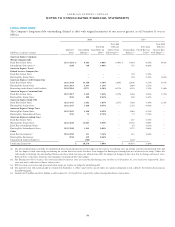American Express 2011 Annual Report Download - page 84
Download and view the complete annual report
Please find page 84 of the 2011 American Express annual report below. You can navigate through the pages in the report by either clicking on the pages listed below, or by using the keyword search tool below to find specific information within the annual report.
AMERICAN EXPRESS COMPANY
NOTES TO CONSOLIDATED FINANCIAL STATEMENTS
FAIR VALUE HEDGES
A fair value hedge involves a derivative designated to hedge the
Company’s exposure to future changes in the fair value of an
asset or a liability, or an identified portion thereof that is
attributable to a particular risk.
Interest Rate Contracts
The Company is exposed to interest rate risk associated with its
fixed-rate long-term debt. The Company uses interest rate swaps
to economically convert certain fixed-rate long-term debt
obligations to floating-rate obligations at the time of issuance. As
of December 31, 2011 and 2010, the Company hedged $17.1
billion and $15.9 billion, respectively, of its fixed-rate debt to
floating-rate debt using interest rate swaps.
To the extent the fair value hedge is effective, the gain or loss on
the hedging instrument offsets the loss or gain on the hedged item
attributable to the hedged risk. Any difference between the
changes in the fair value of the derivative and the hedged item is
referred to as hedge ineffectiveness and is reflected in earnings as a
component of other, net expenses. Hedge ineffectiveness may be
caused by differences between the debt’s interest coupon and the
benchmark rate, which are primarily due to credit spreads at
inception of the hedging relationship that are not reflected in the
valuation of the interest rate swap. Furthermore, hedge
ineffectiveness may be caused by changes in the relationship
between 3-month LIBOR and 1-month LIBOR rates, as these
so-called basis spreads may impact the valuation of the interest
rate swap without causing an offsetting impact in the value of the
hedged debt. If a fair value hedge is de-designated or no longer
considered to be effective, changes in fair value of the derivative
continue to be recorded through earnings but the hedged asset or
liability is no longer adjusted for changes in fair value due to
changes in interest rates. The existing basis adjustment of the
hedged asset or liability is then amortized or accreted as an
adjustment to yield over the remaining life of that asset or liability.
Total Return Contract
The Company is hedging the exposure to changes in the fair
value of its equity investment in ICBC in local currency. The
Company uses a TRC to transfer this exposure to its derivative
counterparty. As of December 31, 2011 and 2010, the fair value
of the equity investment in ICBC was $359 million (605.4
million shares) and $475 million (638.1 million shares),
respectively. Effective August 1, 2011, the Company hedged the
full local currency amount of its investment in ICBC. To the
extent the hedge is effective, the gain or loss on the TRC offsets
the loss or gain on the investment in ICBC. Any difference
between the changes in the fair value of the derivative and the
hedged item results in hedge ineffectiveness and is recognized in
other, net expenses in the Consolidated Statements of Income.
As of December 31, 2010, the Company’s investment in ICBC
was not hedged.
The following table summarizes the impact on the Consolidated Statements of Income associated with the Company’s hedges of fixed-
rate long-term debt and its investment in ICBC for the years ended December 31:
(Millions)
Gains (losses) recognized in income
Derivative contract Hedged item Net hedge
ineffectiveness(a)
Derivative relationship Location
Amount
Location
Amount
2011 2010 2009 2011 2010 2009 2011 2010 2009
Interest rate contracts Other, net expenses $ 128 $ 246 $ (446) Other, net expenses $ (102) $ (233) $ 437 $26$13$(9)
Total return contract
Other non-interest
revenues $ 100 $–$–
Other non-interest
revenues $ (112) $–$–$ (12) $–$–
(a) Net hedge ineffectiveness on the TRC is reclassified from other non-interest revenues to other, net expenses.
The Company also recognized a net reduction in interest expense
on long-term debt and other of $503 million, $522 million and
$464 million for the years ended December 31, 2011, 2010 and
2009, respectively, primarily related to the net settlements
(interest accruals) on the Company’s interest rate derivatives
designated as fair value hedges.
CASH FLOW HEDGES
A cash flow hedge involves a derivative designated to hedge the
Company’s exposure to variable future cash flows attributable to a
particular risk. Such exposures may relate to either an existing
recognized asset or liability or a forecasted transaction. The
Company hedges existing long-term variable-rate debt, the
rollover of short-term borrowings and the anticipated forecasted
issuance of additional funding through the use of derivatives,
primarily interest rate swaps. These derivative instruments
synthetically convert floating-rate debt obligations to fixed-rate
obligations for the duration of the instrument. As of December 31,
2011 and 2010, the Company hedged $305 million and $1.3 billion
of its floating-rate debt using interest rate swaps, respectively.
For derivatives designated as cash flow hedges, the effective
portion of the gain or loss on the derivatives is recorded in AOCI
and reclassified into earnings when the hedged cash flows are
recognized in earnings. The amount that is reclassified into
earnings is presented in the Consolidated Statements of Income
inthesamelineiteminwhichthehedgedinstrumentor
transaction is recognized, primarily in interest expense. Any
ineffective portion of the gain or loss on the derivatives is
reported as a component of other, net expenses. If a cash flow
hedge is de-designated or terminated prior to maturity, the
amount previously recorded in AOCI is recognized into earnings
over the period that the hedged item impacts earnings. If a hedge
relationship is discontinued because it is probable that the
forecasted transaction will not occur according to the original
strategy, any related amounts previously recorded in AOCI are
recognized into earnings immediately.
82
























